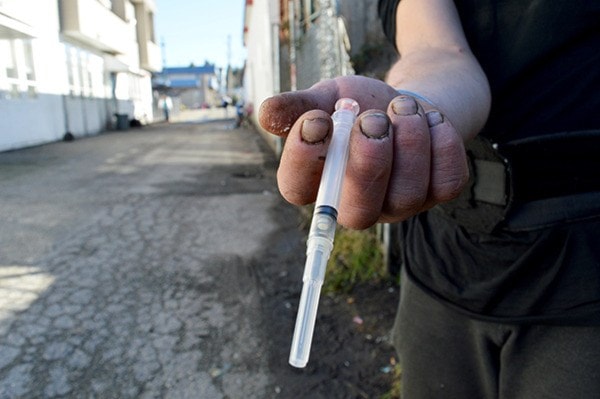 I thought I was watching a man die.
I thought I was watching a man die.
I couldn’t shake this stark realization as I stared at the five-minute-and-thirty-four second recording on my phone the next day.
I was almost too scared to play it.
Less than five minutes into an interview the night before with Pop-Up Soup Kitchen founder Erin Schulte, two people overdosed within a block of where I stood.
People screamed for help, running every which way. It was chaotic. Frantic.
I could see one person on the ground down Surrey's 135A Street.
“The bad drugs are here,” Schulte said.
She’s used to this. It’s a daily occurrance.
Even from that distance, the man appeared lifeless. His face a pale blue, his body limp against the chain link fence and sidewalk.
I walked toward him.
My heart sinks. I know this man. I sat across the table from him inside the emergency shelter and heard his story 21 days before.
His name is Jeff.
There I stood, mere feet away from him as staff from Whalley’s emergency shelter inject him, not once but twice, with naloxone (aka Narcan).
It’s hoped the drug will stop the overdose. Give him more time.
People surrounded him, cried out for Jeff to make it through this.
I was frozen in shock. Things seemed to be happening in slow motion. I felt as though I was watching a movie.
As a reporter, my instinct is usually to capture the reality that surrounds me. But three whole minutes went by before the thought even crossed my mind.
Instead, all I could think about was Jeff. I thought I was watching a man die. But he didn’t die that day, thanks to naloxone. It has saved countless more lives in Surrey.
I spoke to Linda Fox the next day, before I worked up the courage to listen to my recording. She oversees the emergency and winter shelters in Surrey.
“It’s hard to explain, that feeling you get, isn’t it?” she asked me. “When you actually think, ‘Oh my God. This guy’s dead.’”
There was a long pause in our conversation. She realized I now understood what that felt like.
Fox was previously the manager of Vancouver’s Yukon Shelter and can’t recall ever needing naloxone there. In Surrey, 10 people needed it that day.
“It’s almost at the point where we need extra staff now,” Fox continued. “An afternoon shift there’s just three people working here.”
I can’t help but wonder if Jeff is still alive.
He got lucky that day.
He was surrounded by staff from the emergency shelter who have Narcan kits at their fingertips.
One day, he might not be close enough. Or his overdose may go too far.
There are those out there who will say it’s his fault, that he shouldn’t be helped. After all, he injected the heroin into his veins – and it won’t be the last time.
I choose to see it differently.
As a medical health officer with Fraser Health recently stressed to me, addiction is a disease.
Our society fails these people. Ask any expert in the matter, as I have, on countless occasions.
They’ll tell you many are dealing with mental illness. Many have experienced trauma – and almost all need help to stop.
Jeff is someone’s child. Jeff is also someone’s father. And I watched as this drug gave him more time.
Hopefully time to get better. But regardless, more time to live.
Obviously, the real answer is to help these troubled people recover from the clutches of their addiction. But that’s a complex puzzle to solve. Our society hasn’t gotten it right yet, and probably won’t anytime soon.
So if we can save lives in the meantime, why wouldn’t we?
Without naloxone, the death overdose statistics I quote in my story this week would be a lot higher.
Without naloxone, I probably would have watched a man die.
So I leave you with this: If you had naloxone in your hand, would you use it to save a “crackhead?”
I hope your answer is, “yes” because behind each “crackhead” is a story. A person. A life. A chance.
I urge you read my three-part series on naloxone to learn more about the life-saving drug and the rules surrounding it – and if your answer was “yes,” how you can help.
(The first story in this series will be released Thursday, March 24.)
Amy Reid is a staff writer with the Now. She can be reached at amy.reid@thenownewspaper.com.
